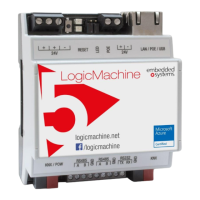
Do you have a question about the Embedded Systems LogiMachine5 Power and is the answer not in the manual?
| Processor | ARM Cortex-A9 |
|---|---|
| Operating System | Linux |
| Memory | 1GB DDR3 |
| Storage | 8GB eMMC |
| Digital I/O | 16x GPIO |
| Operating Temperature | -20°C to 60°C |
Details how to connect power for LM5 and KNX line.
Explains regular and passive PoE powering modes for LM5.
How to view fieldbus power consumption mapped to KNX objects.
Describes the configuration and usage of RS-485 serial ports.
Explains the setup and operation of the RS-232 serial port.
Lists all supported communication protocols and standards for LogicMachine.
Step-by-step guide for physically connecting the device.
Provides default credentials and IP address for initial access.
Explains how to reset the device to factory default settings.
Details how to configure network IP settings for the device.
Methods to find the device's IP address on the network.
Procedure for updating the device's software firmware.
How to integrate LogicMachine with ETS for KNX configuration.
Configuration options for KNX connection and IP routing.
Essential security recommendations for device installation and network setup.
Basic steps to create a visualization using the MOSAIC application.
Instructions for creating visualizations accessible on specific devices.
How to change the interface's visual appearance and language settings.
Method for searching and locating installed applications within the interface.
Steps to unlock the interface for rearranging or hiding application icons.
Managing applications through the administrator mode.
Adding and managing various scripts for automation logic.
Managing KNX network objects, including their parameters and visualization.
Viewing historical telegrams and logs for KNX objects.
Administration of user mode schedulers for time-based automation.
Managing trend logs for historical object data visualization.
Creating and managing automation scenes visually.
Defining the structure of visualizations, including levels and plans.
Tools for creating and managing graphical visualizations.
Managing icons, images, and backgrounds for visualizations.
Using custom CSS for advanced visualization design.
Setting the device's network hostname for identification.
Procedure for modifying the administrator account password.
Managing installed software packages on the system.
Steps to update the device's operating system and LogicMachine software.
Command to restart the LogicMachine device.
Safely shutting down the LogicMachine device.
Configuring network interface settings like Ethernet.
Detailed settings for establishing and managing the KNX network connection.
Viewing network statistics related to KNX communication.
Configuration options for the BACnet server.
Viewing objects that are exported to the BACnet network.
Configuring additional HTTP ports for the web server.
Setting up NTP for time synchronization.
Managing SSL certificates for secure HTTPS connections.
Enabling and configuring the FTP server for file access.
Configuring remote access services for device management.
Tools for monitoring system processes and hardware status.
Enabling remote SSH access for diagnostic support.
Specifying NTP servers for time synchronization.
Viewing overall system information like CPU usage and uptime.
Accessing network tools like Ping and Traceroute.
Reviewing operating system logs for troubleshooting.
Monitoring currently active system processes.
Defining events for user mode schedulers based on time or conditions.
Specifying holidays that affect scheduler behavior.
Configuring logs to track and graph object data over time.
Generating a direct link to a specific trend log.
Using Lua functions to retrieve and process trend log data.
Defining the hierarchical structure of visualizations (buildings, floors, rooms).
Using layouts as templates and configuring widgets for visualizations.
Tools for designing and editing visualization maps, adding objects, links, and labels.
Configuring visualization properties for objects, including display modes and icons.
Creating navigation links between different visualization floors or plans.
Adding and customizing text labels within visualizations.
Incorporating images from the internet or local files into visualizations.
Embedding third-party applications or web content within visualizations.
Visualizing object values using gauge elements.
Integrating IP web cameras into the visualization system.
Displaying real-time data trends using graph visualizations.
Defining device profiles for Modbus communication using JSON.
Using the interface to test Modbus read operations.
Scanning for connected Modbus RTU devices on RS-485 ports.
Configuring serial port parameters for Modbus RTU.
Adding Modbus devices and mapping them to KNX addresses.
Setting the address for specific Modbus devices.
Lua script examples for implementing Modbus slave functionality.
Configuring BACnet server settings and supported BIBBs.
Using BACnet client mode to interconnect with systems like VRV.
Configuring DALI devices, mapping them to KNX objects.
Controlling DALI devices using Lua scripts via the `dalicmd` function.
Using Lua libraries for DMX protocol communication.
Managing EnOcean interfaces and base addresses.
Mapping received telegrams from EnOcean devices to KNX group addresses.
Adding and pairing EnOcean devices for KNX communication.
Using RAW format for unsupported EnOcean device profiles.
List of available profiles for various EnOcean devices.
SMS examples for binary write, scaling write, and temperature setpoints.
Script for sending SMS notifications based on group events.
Using Twilio service for sending SMS via internet connection.
Managing profiles for supported BLE devices.
Mapping BLE device functions to KNX addresses.
Installing SIP packages for door entry system integration.
XML request format for retrieving alert data.
XML request format for retrieving error data.
Overview of the Function Block editor interface and its components.
Common controls and functions within the FB editor, like undo, save, and preview.
Steps to create and manage new logic diagrams in the editor.
How to add and set up function blocks within a diagram.
Configuring the properties of function blocks, including inputs and outputs.
Implementing cyclic execution logic using timer function blocks.
Creating logic triggered by events using event function blocks.
Connecting function blocks using storage or event objects.
Developing and defining custom function blocks using user libraries.